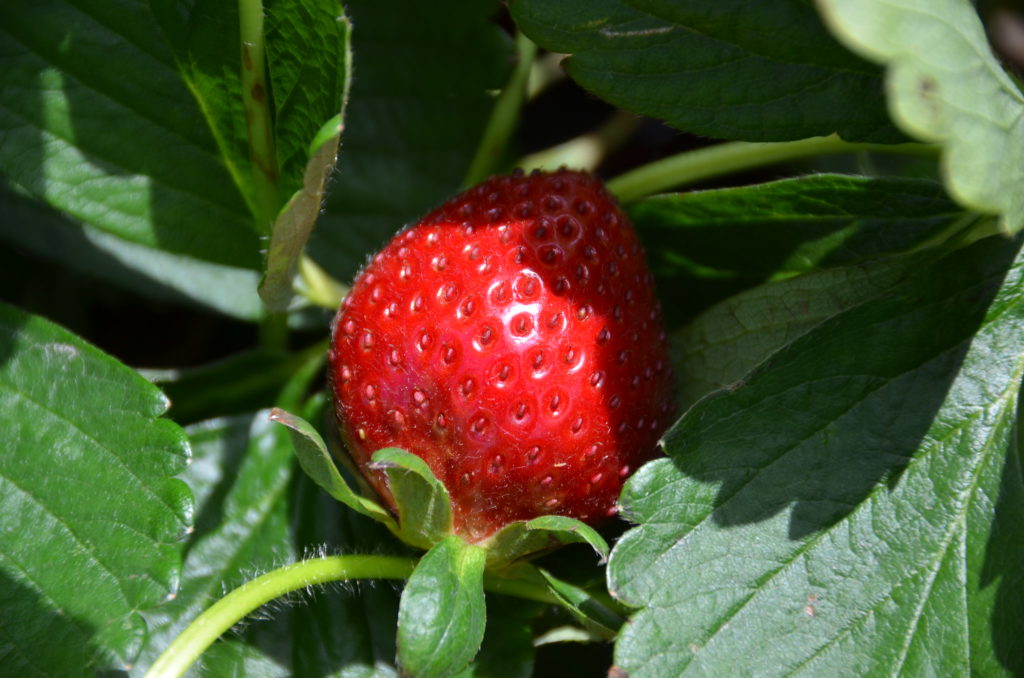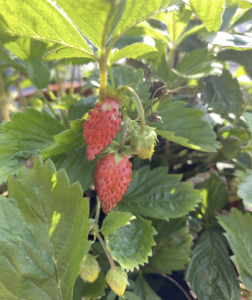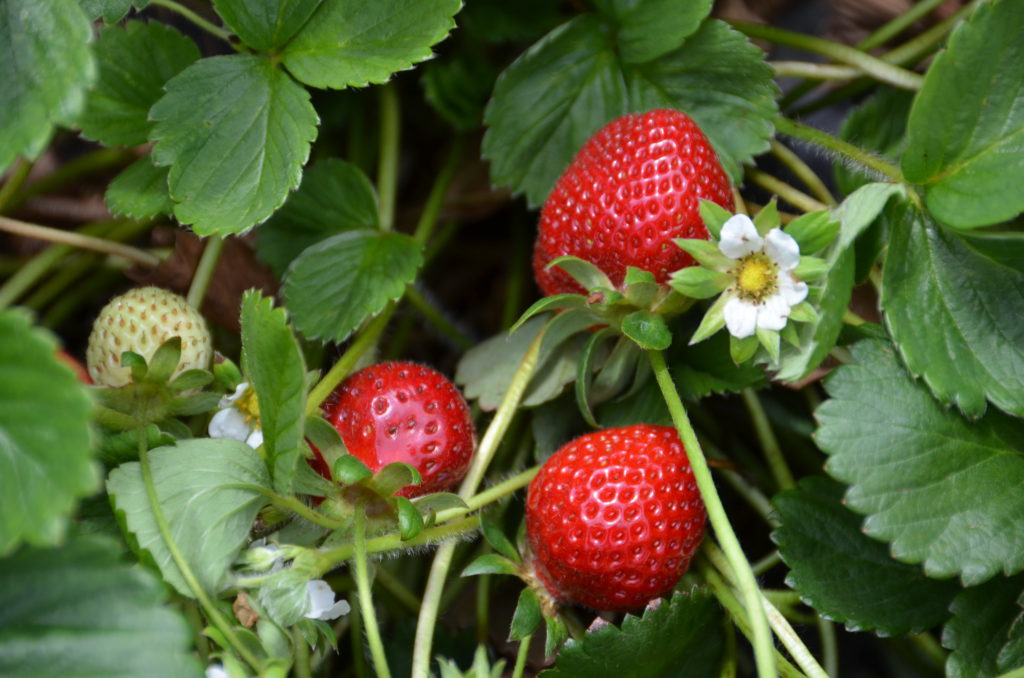The garden strawberry is a cultivated crossbreed between wild strawberries native to eastern North America and present-day Chile in South America. Wild European strawberries, Fragaria vesca and Fragaria moschata, were cultivated in Europe from Roman times, and through the middle ages. The varieties native to the Americas were brought back and grown in France. The garden strawberry known today was first developed in the 1700s, has developed into a large number of varieties and types and has much larger and sweeter fruits than wild strawberries.
There are three general categories of strawberries that are related to how they mature and bear fruit. June-bearing Strawberries (sometimes called Short Day Strawberries) bear fruit that matures once per year as a large crop. These will mature in late spring through early summer (usually in June). Everbearing Strawberries bear fruit in large amounts twice per year, the first early in the season and then again in the early fall. The harvest times for both types are related to the length of the day at that time of year. Day-Neutral Strawberries were bred from everbearing types. These will bear fruit gradually and consistently over the course of the summer, with no change in production during the longer days.

Strawberries are used in a number of ways, including being eaten raw, in salads, baked, used in smoothies, and to make strawberry jam! They are a great source of nutrition, being high in vitamin C and antioxidants, and are a good source of potassium. They are high in fiber, as well as being low in calories and low in carbohydrates.
- Strawberry: Fragaria ananassa
- Perennial (3-4 years max, sometimes grown as annuals)
- Full sun
- Soil acidity should be slightly acidic (5.4 to 6.5 ph).
- Well-drained fertile soil.
- Garden planting:
plant crowns 12” apart
6” deep hole, with the roots spread out
Fill the hole up to the crown (don’t bury the crown)
- Container planting
plant crowns with 12” between plants, or one plant in a 12” wide container
Keep well-watered, and ensure good sunlight
- Climate Zones 4-10 (as perennials 5-8)
Young everbearing or June-bearing strawberries should be planted in early spring, after the last frost. Day-neutral strawberries can be grown successfully this way also. In warmer climates, day-neutral strawberries can also be grown as an annual, and planted at the end of summer or early in the fall, to take advantage of the somewhat cooler temperatures of fall and winter. The soil should be very slightly acidic, but fertile and well-drained. It’s a good idea to dig fairly deeply where you are planting them, at least a foot deep or a little more. Completely clear out any weeds that may be there. If needed, add compost. The soil does need to be slightly acidic, test kits will be helpful for this.
 Before planting, trim the roots of the crowns slightly, and soak them for a few hours. Dig down a bit in the area prepared for them, spread the roots out over a small rounded hill of soil in the hole, and bury the roots completely. Leave the crown itself exposed, with the soil level even with the bottom of the crown (don’t cover it). Water thoroughly, and leave about 12 inches between each plant, and about two-three feet between each row. Alternatively, plant a double row18” apart between rows and an aisle 2.5 feet wide. Leaving some extra space between plants is OK, this will leave room for runners to be removed and either discarded or replanted. It’s best to use a thick layer of mulch, like straw or newspaper, around the plants. This will keep pests and weeds down to some degree, and ensure the soil stays moist and not overheated. Strawberries need frequent watering, about 1-2 inches once per week if you don’t get that much rain. More frequent watering may be needed in dry spells.
Before planting, trim the roots of the crowns slightly, and soak them for a few hours. Dig down a bit in the area prepared for them, spread the roots out over a small rounded hill of soil in the hole, and bury the roots completely. Leave the crown itself exposed, with the soil level even with the bottom of the crown (don’t cover it). Water thoroughly, and leave about 12 inches between each plant, and about two-three feet between each row. Alternatively, plant a double row18” apart between rows and an aisle 2.5 feet wide. Leaving some extra space between plants is OK, this will leave room for runners to be removed and either discarded or replanted. It’s best to use a thick layer of mulch, like straw or newspaper, around the plants. This will keep pests and weeds down to some degree, and ensure the soil stays moist and not overheated. Strawberries need frequent watering, about 1-2 inches once per week if you don’t get that much rain. More frequent watering may be needed in dry spells.
Strawberries can also be grown from seed. These should be started indoors after a process called “cold stratification.” The seeds need to be exposed to cold as part of the maturation process. Put the seeds in your freezer for about a month, during December, and then bring the seeds out and let them thaw to room temperature. Plant them in potting soil with small starter pots or starter trays, with a light covering of soil, and put growing lights shining from above. They will germinate anywhere from 1 to 6 weeks later if the soil is kept moist and warm. Once they are growing, transplant them into larger containers. Wait until after the last frost to transplant into the garden, or keep them as potted plants.
Strawberries are perfect for containers as well. You will need a fairly large pot, about 12 inches wide, and at least 8 inches deep, with good drainage holes. The usual advantages of using containers all apply here, including having control over the available light, good pest control, easy to maintain soil, and preservation of space. Strawberries transplanted to pots will do well quickly, and a crown can be planted directly in a pot as easily as in a garden bed. Container plants usually last 2-3 years, as compared to 3-4 years for garden strawberries. It’s important to water more frequently, even daily, as the soil will dry out more quickly. Ensure that they get enough sunlight. Water more often than garden strawberries, usually twice per week, or as often as daily in dry spells. Ensure good nutrition for potted strawberries, since they don’t have access to the full range of nutrients available in the garden. A good soil level spray of liquid fertilizer every few weeks is usually fine. Move the pots into a sheltered but unheated area for the winter. They will become dormant naturally, but the containers will need some protection from the cold.

Borage may be the best companion plant for strawberries in your garden. This plant attracts pollinators and repels some pests, including hornworms. It adds nutrition to the soil which is helpful for strawberries in particular. Other plants that are good to attract pollinators include lavender, also a great companion. Beans and peas are a good choice, as are lettuce and spinach. Garlic and onions work very well with strawberries and their strong smell will repel many pests. It’s important to avoid planting brassicas like kale, collard greens, cabbage, mustard greens, broccoli, or Brussels sprouts near strawberries since they will interfere with each other’s growth. Tomatoes, peppers, and potatoes are also important to keep separate.
Pests that will trouble strawberries include strawberry bud weevils (strawberry clippers), spider mites, hornworms, loopers, thrips, and Japanese beetles. Slugs can also be a problem. It’s important to check for slime trails, and manually remove any slugs as they appear. Fungal diseases can also be an issue. Some common ones are powdery mildew, gray mold, anthracnose, and unfortunately, verticillium wilt. Neem oil spray is an effective organic treatment for many fungal diseases, but prevention is the best cure. It’s important to plant strawberries that are disease free. Water your plants at ground level (avoid overhead sprays), and keep your plants well-spaced. Angular leaf spot is the most common bacterial disease. This is spread by pests, and again, prevention, including ground watering, is best.
To harvest the berries, wait until they are fully ripe. Check the color and firmness. They will be completely ripe when there is no green left in the tip or near the stem. Pinch the stem, and leave a short piece of it attached to the strawberry to avoid bruising the fruit. They should be used as soon as possible, they don’t last long. If you have a large harvest, save the ones not used right away by freezing them. Cut them in half, and lay them out on parchment on a large metal tray. Put them in the freezer overnight, and once they are completely frozen, you can easily store them in a freezer bag for later use.











